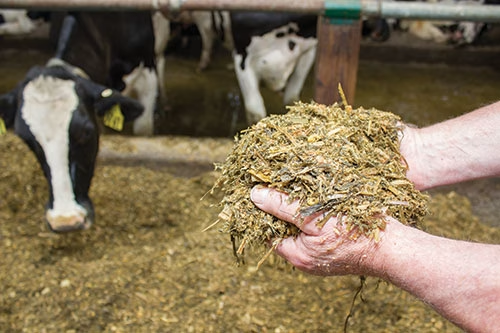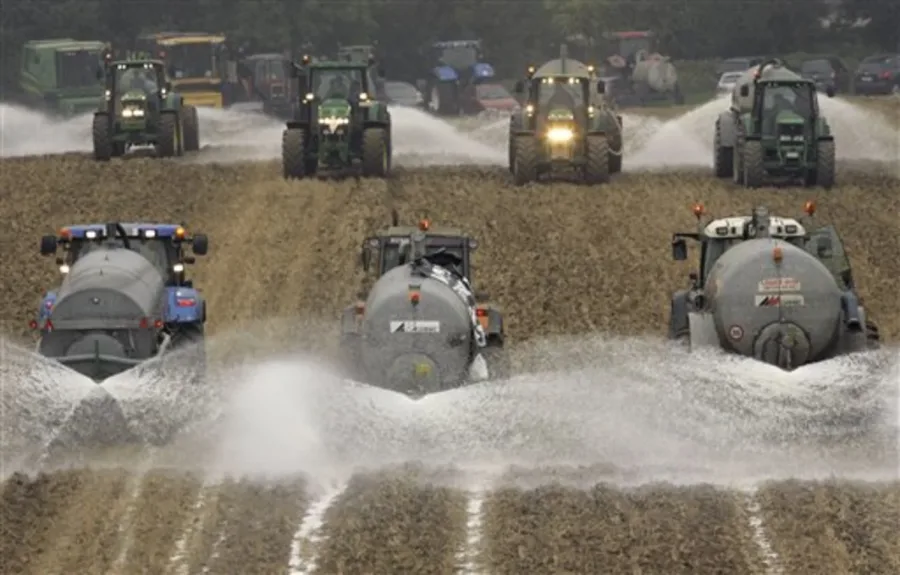Learn how efficient silage preservation methods can significantly cut greenhouse gas emissions in dairy farming. Are you prepared to reduce your farm’s carbon footprint and enhance sustainability?

As global temperatures rise and environmental concerns grow, the agricultural sector, especially dairy farming, stands at a pivotal point. Dairy farming contributes to greenhouse gas emissions, prompting urgent action. With methane emissions from cows, carbon dioxide from growing feed, and nitrous oxide from manure, innovative solutions are essential. One promising strategy is careful silage preservation, balancing productivity with sustainability.
Advanced silage techniques, like using specific microbial inoculants, can significantly reduce emissions. For example, homofermentative inoculants improve fermentation, preserving nutrients and reducing spoilage. This enhances feed efficiency and lowers methane production, making it a crucial strategy for sustainable dairy farming.
The dairy industry‘s efforts to reduce emissions are vital. These strategies help meet climate goals, improve public image, and offer ecological and economic benefits. Each individual’s contribution is significant in this collective effort.
Proper silage techniques using homofermentative and heterofermentative inoculants significantly cut greenhouse gas emissions. These methods improve forage quality, dry matter recovery, and aerobic stability, aiding overall emission reduction in dairy farming.
This article explores the critical role of efficient silage preservation in reducing greenhouse gas emissions from dairy farming, outlining key strategies and successful case studies.
Silage Preservation: A Key Strategy for Nutritional Consistency and Emissions Reduction
Silage preservation, which ferments and stores green forage crops in an air-free environment, is essential for dairy farming. This method provides a steady feed supply year-round, despite seasonal changes, and helps reduce greenhouse gas emissions. Efficient fermentation reduces methane and other harmful gases, making dairy practices more sustainable.
The use of microbial inoculants in silage preservation plays a vital role in improving the feed’s nutrient quality. These inoculants, which are typically bacteria, lead the fermentation process, quickly lowering pH levels and keeping nutrients and energy intact. This process boosts aerobic stability and reduces heating, thereby preserving the silage’s quality and nutrition. The result is a significant reduction in greenhouse gas emissions, making dairy practices more sustainable.
High-quality silage is crucial for animal nutrition, offering digestible and nutrient-rich feed that benefits dairy cattle’s health, milk production, and well-being. Essential factors like fermentation rate, nutrient conservation, fiber digestibility, and storage life enhance the feed. Research shows that inoculated silage increases milk production and improves stability, cutting down on spoilage and waste.
Understanding the Importance of Silage Preservation Within Dairy Farming Sustainability
Practical silage preservation ensures a consistent, high-quality feed supply throughout the year, directly impacting milk production efficiency and herd health. Advanced silage preservation methods are vital for environmental stewardship and economic success in dairy farming.
Traditional methods like dry hay production depend on the weather and often lose nutrients. In contrast, wet silage kept without oxygen maintains better feed quality and stable nutritional content. Silage inoculants with particular microorganisms enhance fermentation, speeding up pH reduction and preserving nutrients.
Controlled microbial fermentation keeps nutrients intact, improves ‘fiber digestibility ‘, which refers to the ability of the animal to break down and utilize the fiber in the feed, and extends bunk life, making forage tasty and nutritious. These advances lead to better milk yield, reduced feed costs, and lower environmental impacts, helping farmers achieve better economic and sustainability goals.
Effective Methods to Mitigate Greenhouse Gas Emissions
Adopting waste reduction strategies is essential to reducing greenhouse gas emissions in dairy farming. Efficient silage preservation is crucial in maintaining nutritional consistency for livestock and lowering emissions.
Timing and harvesting methods are vital. Harvesting crops at the correct moisture content (60-70%) ensures good fermentation, less spoilage, and reduced methane emissions from better feed preservation.
Using additives and inoculants helps improve fermentation and cut spoilage. Homofermentative inoculants quickly lower pH levels, stopping harmful bacteria and keeping plant proteins intact. This leads to better aerobic stability, less heating, and improved feed efficiency.
Inoculants like probiotics and enzymes enhance silage fermentation. Probiotics, like certain lactic acid bacteria, help preserve nutrients. At the same time, enzymes break down complex carbs, making nutrients easier for animals to digest.
Proper silage storage and management are crucial for quality and emission reduction. Storing silage in airtight conditions prevents aerobic spoilage and methane emissions.
These practices align dairy farming operations with global sustainability goals and improve economic viability by boosting feed efficiency and animal productivity.
Case Studies: Successful Silage Strategies in Dairy Farms
Green Pastures Dairy in Wisconsin serves as a shining example of the success of advanced silage preservation methods. By using homofermentative inoculants, they improved dry matter recovery and reduced methane emissions by an impressive 12%. These inoculants also enhanced aerobic stability by 15%, significantly reducing spoilage.
Sunnybrook Farms in California saw similar benefits using microbial inoculants and better silage compaction. They achieved a 20% increased lactic acid production and cut GHG emissions by 10%. Improved feed quality also raised milk yields by 8%, showing environmental and economic gains.
Both farms emphasized the importance of monitoring moisture content, chop length, and compaction and recommended careful silage management. Working with agricultural scientists and staying informed about new research was also crucial in improving their preservation methods.
The Bottom Line
Reducing dairy emissions is essential to combat climate change. Dairy farming emits many greenhouse gases, so adopting sustainable practices is critical to the environment.
Efficiently preserving silage is a key strategy. Techniques like microbial inoculants, which promote quick pH drops, and homofermentative bacteria, which improve energy efficiency, help maintain feed quality and reduce emissions.
Dairy farmers play a pivotal role in the transition to a more sustainable future. By adopting and championing these methods, they not only ensure their economic viability but also demonstrate their commitment to environmental responsibility.
Key Takeaways:
- Silage preservation helps in maintaining feed quality, which directly impacts animal health and productivity.
- Advanced preservation techniques can reduce methane emissions from enteric fermentation by improving feed efficiency.
- Proper storage and management of silage minimize losses and reduce the need for additional feed production, thus cutting down related GHG emissions.
- The use of inoculants in silage can enhance fermentation processes, ensuring better nutrient preservation and lower emission levels.
Summary:
Dairy farming contributes to 4% of global greenhouse gas emissions, causing methane, carbon dioxide, and nitrous oxide levels to rise. To combat this, dairy farmers must adopt sustainable practices, aligning with the Paris Agreement. Proper silage preservation techniques using homofermentative and heterofermentative inoculants can significantly reduce emissions, improving forage quality, dry matter recovery, and aerobic stability. Other factors contributing to emissions include enteric fermentation in cows, growing and preserving feed crops, and managing manure. A combined approach, including improved feed efficiency, better manure management, and optimized feed crop growth and storage, is necessary. Silage preservation is crucial for dairy farming, providing a steady feed supply and reducing greenhouse gas emissions. Advanced silage preservation methods are essential for environmental stewardship and economic success. Timing and harvesting methods are essential for maintaining nutritional consistency and lowering emissions. Inoculants like probiotics and enzymes can enhance silage fermentation, preserving nutrients and breaking down complex carbohydrates. Proper silage storage and management are essential for quality and emission reduction, aligning dairy farming operations with global sustainability goals and improving economic viability.












